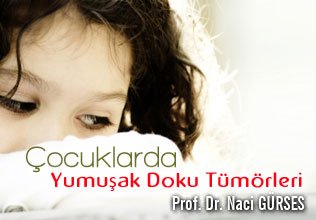
RABDOMYOSARCOMA: Rhabdomyosarcoma, which is the most common soft tissue tumor in childhood, constitutes 5 – 8% of cancers in this age. They can be found in any anatomical region. They are most commonly found in the head and neck (40%), genito-urinary system (20%), extremities (20%), and trunk (10%). Retroperitoneal region (posterior abdominal wall) and other regions (10%). Extremity lesions are more common in older children and have an alveolar histological structure.
Its higher incidence in patients with rhabdomyosarcoma neurofibromatosis suggests a genetic effect. Rhabdomyosarcoma is thought to develop from the same embryonic leaf as the striated muscles. According to light microscope images, it belongs to the group of small round cell tumors that also includes Ewing’s sarcoma, neuroblastoma, and non-Hodgkin’s lymphomas. Immunohistochemical studies using skeletal muscle-specific antibodies and electron microscopy may be required for the definitive diagnosis of the pathological specimen. Determination of the specific histological type is important in treatment planning and prognosis.
There are 4 known histological types of rhabdomyosarcoma:
a- Embryonic type: It constitutes 60% of all cases. It has a moderate prognosis.
b- Botroid type: It is a variant of the embryonic form. Tumor cells make grape bunch-like extensions into the body cavity. It constitutes 6% of such cases and is frequently seen in the vagina, uterus, bladder, nasopharynx and middle ear.
c- Alveolar type: They constitute 15% of all cases. Tumor cells tend to develop to form alveoli-like structures. It is most common in the trunk and extremities and has the worst prognosis.
d- Pleomorphic type (Adult form): It is rare in children. It constitutes only 1% of cases. Rhabdomyosarcomas most commonly present with a painful and painless mass. Findings result from displacement or occlusion of normal structures. A tumor originating from the nasopharynx may cause edema, respiratory disorders, nosebleeds, difficulty in swallowing and chewing. Intracranial spread of the tumor may cause cranial nerve palsy, blindness, and headache and nausea due to increased intracranial pressure.
Primary ocular base tumors are diagnosed early due to edema, ptosis and visual impairment around the eye. Tumors in the middle ear develop chronic otitis, hearing loss, and intracranial findings on the affected side. Trunk and extremity rhabdomyosarcoma is often first noticed after trauma and may initially be mistaken for a hematoma. If the swelling does not decrease or increases, malignancy should be suspected. As a result of genito-urinary system involvement, hematuria, lower urinary tract obstruction, recurrent urinary tract infections, incontinence can be seen. Paratesticular tumors usually present as a painless, rapidly growing mass in the scrotum.
Vaginal rhabdomyosarcomas may occur as a grape-like mass hanging in the mouth of the vagina (Bothroid Sarcoma) and may cause urinary tract and large bowel symptoms. Tumors formed in any region can cause respiratory distress with early spread and lung metastases. Widespread bone involvement may cause symptomatic hypercalcemia, and detection of the primary lesion may be difficult in such patients. Definitive diagnosis in patients is possible with biopsy, microscopic image and immunohistochemical staining. Unfortunately, months often pass between the initial symptoms of the disease and the biopsy. Diagnostic procedures are basically determined according to the region of the disease. MR, CT and ultrasonography play an important role in the diagnosis and determination of distant metastases.
The most important step in the diagnostic study is the evaluation of tumor tissue. For this, special histochemical and immunostains are used. Treatment; Patients with tumors that can be completely removed surgically have the best prognosis. Unfortunately, most rhabdomyosarcomas cannot be completely resected. Before surgical treatment, the clinical stage of the disease should be determined by investigating regional lymph nodes, metastases and surrounding tissues.
Preoperative chemotherapy may be required to reduce the surgical area.
Clinically;
Group-1: After complete removal of the lesion in tumors, chemotherapy is applied to prevent metastasis in the future.
Group-2: Following tumor removal, local radiotherapy and systemic chemotherapy are applied to destroy residual tumor cells.
Group-3: Chemotherapy and radiotherapy are applied for the tumor left behind macroscopically after surgery, followed by surgery for the remaining tumor tissue.
Group-4: Systemic chemotherapy and radiotherapy are applied in cases with metastatic tumors. In patients with tumor completely removed by surgical intervention, 80 – 90% survival and recovery from the tumor can be achieved. In cases that cannot be completely removed by surgery, long-term disease-free cure can be achieved up to 70% with radiotherapy and chemotherapy applied following surgery. Children with extensive disease have a poor prognosis, with only 50% of them achieving remission. Cure can be achieved in less than half of the cases in which remission can be achieved. The prognosis in older children is worse than in the younger age group.
OTHER SOFT TISSUE SARCOMS
Other soft tissue sarcomas other than rhabdomyosarcoma are extremely rare in children. The most common ones are according to their histological structures; They are synovial sarcoma, fibrosarcoma, malignant fibrous histocytoma, leiomyosarcoma and tumors of neurogenic origin. These often occur on the trunk and lower extremities. Surgery is the mainstay of treatment. Before surgical intervention, the clinical stage of the tumor should be carefully investigated. Spread to lymph nodes is rare. However, it should be investigated whether there is bone and lung spread. Chemotherapy and radiotherapy should be considered in large and incompletely excised tumors. Because of their rarity, the prognosis is not as well defined as rhabdomyosarcomas. In metastatic cases, chemotherapy and radiotherapy should be applied in addition to surgery. Keywords : Soft Tissue Tumors in Children Rhabdomyosarcoma Synovial Sarcoma Fibrosarcoma Malignant fibrosis histiocytoma Leiomyosarcoma Tumors of neurogenic origin

